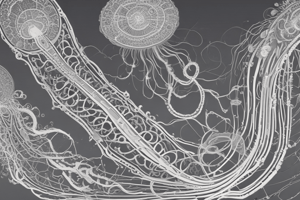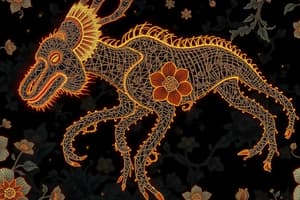Podcast
Questions and Answers
Homeotic transformations refer to the replacement of one segment of an organism by a structure characteristic of a different segment.
Homeotic transformations refer to the replacement of one segment of an organism by a structure characteristic of a different segment.
True (A)
Antennapedia is a non-Hox gene that plays a role in segment polarity.
Antennapedia is a non-Hox gene that plays a role in segment polarity.
False (B)
Hox genes are characterized by a specific protein fold called a homeobox which allows them to bind to RNA.
Hox genes are characterized by a specific protein fold called a homeobox which allows them to bind to RNA.
False (B)
Spatial colinearity refers to the ordering of Hox genes along the chromosome corresponding with their expression patterns along the head-tail axis.
Spatial colinearity refers to the ordering of Hox genes along the chromosome corresponding with their expression patterns along the head-tail axis.
Engrailed is a Hox gene that is important for limb development.
Engrailed is a Hox gene that is important for limb development.
Survivors never develop cancer early in life.
Survivors never develop cancer early in life.
Axis regionalization starts after the emergence of vertebrae.
Axis regionalization starts after the emergence of vertebrae.
Hox genes are responsible for regulating proximal to distal patterning.
Hox genes are responsible for regulating proximal to distal patterning.
The pinky is associated with the anterior part of the limb.
The pinky is associated with the anterior part of the limb.
Polysyndactyly is characterized by many fingers being fused.
Polysyndactyly is characterized by many fingers being fused.
The loss of radius and ulna in mice is complete.
The loss of radius and ulna in mice is complete.
HOX genes influence the formation of both proximal and distal structures in limbs.
HOX genes influence the formation of both proximal and distal structures in limbs.
Loss of d11 is not associated with any developmental disorders in humans.
Loss of d11 is not associated with any developmental disorders in humans.
The expression of HOX genes determines the shape of the vertebrae.
The expression of HOX genes determines the shape of the vertebrae.
NMPs are responsible for forming the anterior somites.
NMPs are responsible for forming the anterior somites.
A shift of HOX gene expression boundaries can lead to different vertebral patterns in organisms.
A shift of HOX gene expression boundaries can lead to different vertebral patterns in organisms.
The first somite is referred to as S1.
The first somite is referred to as S1.
Hox genes expressed in the somites influence limb development.
Hox genes expressed in the somites influence limb development.
Deletion of Hox10 genes leads to normal vertebral development.
Deletion of Hox10 genes leads to normal vertebral development.
80% of fetuses with extra cervical ribs die before birth.
80% of fetuses with extra cervical ribs die before birth.
The HOX gene Hox c4 is expressed in the posterior region.
The HOX gene Hox c4 is expressed in the posterior region.
Mouse-like vertebral patterns occur when the expression of specific HOX genes shifts in one direction.
Mouse-like vertebral patterns occur when the expression of specific HOX genes shifts in one direction.
Somites give rise to various structures including vertebrae.
Somites give rise to various structures including vertebrae.
Flashcards
Hox genes
Hox genes
Genes that determine the body plan of an organism by regulating the development of specific body segments.
Homeotic transformation
Homeotic transformation
Replacement of a body part with a different structure, typical of a different body region.
Spatial colinearity
Spatial colinearity
The order of Hox genes on the chromosome matches the order of their expression along the body axis (head to tail).
Antennapedia gene
Antennapedia gene
Signup and view all the flashcards
Ultrabithorax gene
Ultrabithorax gene
Signup and view all the flashcards
Somites
Somites
Signup and view all the flashcards
Hox gene expression
Hox gene expression
Signup and view all the flashcards
Colinear Hox code
Colinear Hox code
Signup and view all the flashcards
Vertebral pattern
Vertebral pattern
Signup and view all the flashcards
Anterior-posterior axis
Anterior-posterior axis
Signup and view all the flashcards
Hox Gene Boundary Shift
Hox Gene Boundary Shift
Signup and view all the flashcards
Mutant vs. WT (in reference to Hox)
Mutant vs. WT (in reference to Hox)
Signup and view all the flashcards
Extra cervical rib
Extra cervical rib
Signup and view all the flashcards
Presomitic mesoderm
Presomitic mesoderm
Signup and view all the flashcards
Presomitic mesoderm specification
Presomitic mesoderm specification
Signup and view all the flashcards
Proximal-distal patterning
Proximal-distal patterning
Signup and view all the flashcards
Limb development
Limb development
Signup and view all the flashcards
Polysyndactyly
Polysyndactyly
Signup and view all the flashcards
Loss of d11/13 genes
Loss of d11/13 genes
Signup and view all the flashcards
Axis regionalization
Axis regionalization
Signup and view all the flashcards
Study Notes
Hox Genes
- Named after the homeobox, a specific protein fold that evolved to bind DNA.
- William Bateson (1894) first described homeotic transformations and coined the term HOMEOSIS.
- HOMEOSIS is the replacement of part of one segment of a segmented animal (like an insect) with a structure characteristic of a different segment. For example, a leg could be replaced by a wing.
- Homeotic genes were first identified.
A gene complex controlling segmentation in Drosophila
- The bithorax gene complex in Drosophila has at least 8 genes that control thoracic and abdominal development.
- The level of repression of at least four of these genes is controlled by cis-regulatory elements.
- A separate locus, called Polycomb, seems responsible for a repressor protein of the complex.
- The state of repression of the genes is controlled via an antero-posterior gradient in the embryo, and a proximo-distal gradient on the chromosome.
Homeotic Selector Genes
- Shown diagrammatically as a fly's body plan and the genes responsible for development.
- The diagram indicates the Antennapedia complex and the bithorax complex, with corresponding genes (e.g., Antp, Ubx, abdA, AbdB) mapped along the head-to-tail axis.
- The diagram shows the correlation between the genes' positions on the chromosome and their expression patterns along the body.
Spatial Colinearity
- The ordering of Hox genes along the chromosome corresponds to their expression patterns along the body axis (head to tail).
Other Genes Involved
- Engrailed: Not a Hox gene but is regulated by Hox genes. Plays a role in segment polarity (defines anterior versus posterior of a segment),
- Antennapedia: A Hox gene.
- Ultrabithorax: A Hox gene.
- Distal-less: Not a Hox gene but regulated by Hox genes. Important for limb development, especially in humans with related genes DLX.
Additional Information on Hox Genes
- Hox genes are transcribed posterior to anterior in relation to the embryo (body).
- Hox genes encode members of the homeodomain protein family.
- These Hox gene proteins bind to DNA, allowing them to control genes, which in turn trigger the development of specific regions of the body.
Functional Redundancy
- Multiple Hox genes can perform the same function.
- This redundancy allows for flexibility and robustness in development.
Transition to Active Chromatin States
- The transition to active chromatin states determines which Hox genes are expressed.
- This process occurs in the developing embryo as somites are constructed.
- Somites are blocks of body tissue; the first somite forms first, somites 2 and 3 are under construction and others will be the next somites.
- FGF is a protein associated with this process influencing formation of the neural tube in embryos.
Hox Genes and Vertebrae
- Somites give rise to vertebrae.
- The shape of the vertebrae is determined by the Hox genes expressed within the somite.
- Hox gene expression patterns differ between chicken and mouse, leading to different vertebral patterns.
Regulatory Mechanisms
- Activation and repression by a colinear Hox code control specific Hox gene expression.
- Shown are images of chicken and mouse embryos illustrating Hox gene expression patterns.
Hox Genes and Limb Development
- Hox genes regulate proximal-distal patterning in limb development.
- Hox genes are essential for specific limb development (forelimb and hindlimb) and dictate which genes (and therefore what tissues) are developing.
Hox Gene Misexpression
- Incorrect expression of Hox genes can result in developmental abnormalities.
- This is shown by images of mouse embryos and human limbs with mis-expression of Hox genes causing anomalies.
Extreme Selection in Humans
- There is a high level of selection against homeotic transformations of the cervical vertebrae in humans.
- In humans, there are almost always exactly 7 cervical vertebrae.
- Fetuses with additional cervical ribs have a very high rate of death before birth or developmental abnormalities, indicating that natural selection strongly favors keeping the cervical vertebrae count stable and unchanging at 7 rather than more than 7 (or less than 7).
Studying That Suits You
Use AI to generate personalized quizzes and flashcards to suit your learning preferences.
Related Documents
Description
Explore the fascinating world of Hox genes, which play a crucial role in the segmentation and development of organisms, particularly in Drosophila. This quiz covers the concepts of homeosis, gene complexes, and regulatory mechanisms that govern developmental processes. Test your understanding of these fundamental genetic principles!




